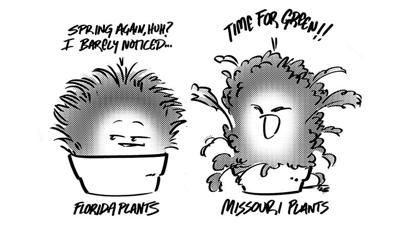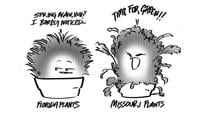The road to my house leads down one steep hill, over a creek and back up another. Driving home, I get a panoramic view of the heavily wooded hillside on the other side of the valley.
In the winter it’s a stark expanse of lifeless gray. But then in early spring, the hillside becomes a pale, shimmery jade haze that signals the world is waking up. The little crocuses poke their bright green stalks up, sometimes through a snowdrift, as insistently as a toddler wanting cereal and cartoons at 7 a.m. on a Saturday. Soon the bushes leaf out, grass begins to show new growth and dandelions begin their insistent campaign to populate every inch of where they’re not wanted.
I love it when green comes back into the world each year.
But this year I saw it in a completely different way.
Over the winter, I spent several months staying with family in Florida. I got to watch the ebb and flow of what passes for “seasons” there.
At first I reveled in the “no winter” situation. It was great not to have to drag armloads of fuel in for the woodstove, or shiver through a trip to take out the garbage or watch each careful step negotiating icy stairs and sidewalks.
And I was really looking forward to things being green all the time.
The trees in Florida never really lose their green; they just cycle through different shades as the seasons turn. What I discovered, though, is there’s a tiredness to the subdued green of late fall, as if the trees are just done with it all and would love to drop their leaves and take a good snooze if they could. It’s as if they’re saying, “Well, OK, I’ll stay green … but I’m not going to work very hard at it.”
Then comes the winter, when bushes and trees are the pale green of cautious growth, conserving resources and patiently waiting for the spring rains. Winter green is a quiet, restful, polite green. It’s a “building fortitude” sort of color, what plants in the semi-tropics show the world as they prepare to face the surface-of-the-sun temperatures of summer.
I came back to Missouri in March, expecting to see green creep back into the landscape here like a barn cat trying to sneak up on a juicy mouse.
Then I came to realize: Green is a totally different color here. And it arrives in a totally different way.
Our trees simply can’t afford the kind of reticence Florida trees display. They don’t have the time. There’s no polite announcement of impending blooms. The oak in my front yard didn’t say, “Pardon me, but I believe I shall begin to grow my leaves now.”
No; here in the Midwest, green comes almost violently, in a riotous, exuberant, fragrant onrush. The most raggedy, worthless little weed bursts proudly forth, thrusting its shoots triumphantly toward the sun with complete confidence that it is adding to the general well-being of the planet simply by existing.
Every roadside, every field, every patch of yard explodes headlong into a stunningly fresh green that almost hurts the eyes. The ugliest, lumpiest scrub of a bush is proud to be part of the verdant symphony, and winding green vines spread over every stone and stump and retaining wall.
These plants are loud and proud. There’s no holding back the sheer exuberance of a clump of Sweet William or Queen Anne’s Lace scattering joy along a roadway, blossoms showing bright amid the deep green of their foliage.
When the summer storms blow through, the tallest trees rustle their bright green leaves boldly in the face of Mother Nature, flaunting their pride of place.
Maybe the plants here feel the underlying truth of Mother Nature – that it’s all ephemeral. They must have some kind of sense, deep down, that their time is fleeting and that only a few short weeks remain before they are forced to wither and fade into another season of deep and silent cold.
They are the embodiment of “making hay while the sun shines,” vowing to be as intensely green as possible while they are able.
The song says, “It’s not easy being green,” and that may be the case for Kermit the frog. Those Florida trees and bushes, with their stately, cautious colorization, may have the right idea.
But when I look around at the lovely, lush green of a Missouri summer, I think maybe the rest of the song has it exactly right.
“I am green, and it’ll do fine. It’s beautiful and I think it’s what I want to be.”




